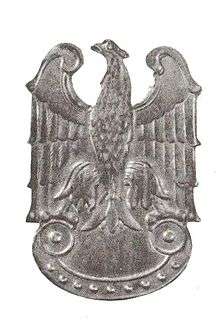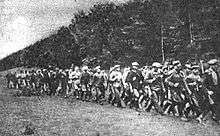Armia Ludowa
Armia Ludowa (AL, pronounced [ˈarmja luˈdɔva]; English: the People's Army) was a communist partisan force set up by the communist Polish Workers' Party (PPR) during World War II. It was created by order of the Polish State National Council on 1 January 1944. Its aims were to fight against Nazi Germany in occupied Poland, support the Soviet Red Army against the German forces and to aid in the creation of a pro-Soviet Union communist government in Poland.
| People's Army | |
|---|---|
| Armia Ludowa | |
 People's Army eagle insignia | |
| Active | 1 January 1944 - 29 July 1944 (transformed into Polish People's Army) |
| Country | Poland |
| Allegiance | Polish Workers' Party |
| Role | Armed forces of the Polish Workers' Party |
| March | Marsz Gwardii Ludowej |
| Engagements | World War II Battle of Porytowe Wzgórze Republic of Pińczów Warsaw Uprising Sandomierz bridgehead |
| Commanders | |
| Notable commanders | Michał Rola-Żymierski Franciszek Jóźwiak Jan Czechowski |
Along with the National Armed Forces, it was one of the military resistance organizations that refused to join the structures of the Polish Underground State or its military arm, the Home Army. The People's Army was much smaller than the Home Army, but propaganda in communist Poland espoused the myth that the reverse was the case.
Due to their close affiliation with the Soviet Union, which de facto controlled Armia Ludowa and its predecessors, Armia Ludowa can be seen as both a part of the Polish resistance as well as the Soviet partisan movement.[1]
Background
In 1939, 17 days after the German invasion, the Soviet Union also invaded Poland. There was no formal declaration of war by either side. The Polish government in exile established in London maintained contacts with its representatives in occupied Poland, the Polish Underground State. In 1943 following the revelations about the Katyn massacre and Polish government insistence on investigation, the Soviet Union broke off the diplomatic relations with the London Polish government, intending to establish a competing structure of power.[1]
Following the German invasion of the Soviet Union, the communist supporters in Poland, aided by Soviet advisers, had formed partisan units and created their own independent underground organization, whose aims were to support the Soviet military against German forces and aid the creation of a pro-Soviet communist government in Poland. Thus the Gwardia Ludowa (GL, People's Guard) was created in 1942. Along with a portion of the National Armed Forces, this communist-led underground was one of the military resistance organizations in Poland that refused to join the structures of the Polish Underground State, and its military arm, the Armia Krajowa.[1]
History
Creation
On 1 January 1944 the State National Council (Krajowa Rada Narodowa, KRN) replaced the Gwardia Ludowa with the AL.[1] The KRN intended to gain volunteers from other groups. Upon its establishment, the organization comprised some 10,000 members. By the end of July 1944 (when much of Poland had been occupied by the Red Army) there were some 20,000–30,000 members,[2] 5,000 of them being Soviet nationals.[3] Lower estimates quote about 14,000 as its peak strength,[4] whereas high estimates double the middle number, up to 50,000–60,000.[3] About 6,000 of them were active full-time partisans. Whatever its exact size, AL was much smaller ("a fraction of") than the primary Polish resistance organization, the Armia Krajowa (Home Army).[5][6][7][8]
At the same time, GL/AL was much better armed than Armia Krajowa (Home Army, AK); thanks to Soviet air drops, and it might have even had a surplus of weaponry.[9] It also had less strict discipline.[9]
Polish People's Army
Seven months after it came into existence, on 21 July 1944, the People's Army was integrated into the Polish Military in the USSR and formed the new People's Army of Poland (Ludowe Wojsko Polskie, LWP).[4] After the Red Army and the Soviet-organized 1st Polish Army entered Poland late in 1944 and early 1945, most People's Army members joined the communist 1st Polish Army. After the war, many of its members joined the ranks of the Ministry of Public Security of the People's Republic of Poland, or the Milicja Obywatelska (police).[2][10][11]
Operations, propaganda and criticism

According to AL's claims, it carried out about 900 operations, killing 20,000 Germans, derailing 350 trains, and destroying 79 bridges.[4] However, GL/AL exploits were significantly exaggerated by the communist propaganda in the People's Republic of Poland.[11][12][13] Polish historian Piotr Gontarczyk estimates that only about 5–10% of officially recorded GL/AL action really took place, and that in the majority instances when GL/AL fought the German military it was when GL/AL was defending itself from German anti-partisan operations, with instances of GL/AL attacking Germans on its own initiative being very rare.[9] Rather than engaging military targets, GL/AL preferred softer targets, such as German administration offices.[9] That changed in 1944, when GL/AL grew stronger, and began engaging the German military more actively.[14] According to Polish-American historian Mieczysław B. Biskupski, AL was less concerned with fighting the Germans than with fighting the Home Army.[5] According to Gontarczyk and Janusz Marszal, however, this was relatively uncommon, at least with regards to direct actions; however GL/AL would often pass anonymous tips about AK to the Gestapo.[15]
The People's Army took part in the Warsaw Uprising. While official claims held that some 1,800 People's Army soldiers fought there, modern research suggests the actual number to have been about 500.[11]
As the GL/AL had a much poorer support network than the Home Army, which was supported by the Polish Underground State, and Soviet air drops did not supply the People's Army with foodstuffs, it often had to resort to forced requisitions, described by modern historians as "banditry".[16] It often targeted mansions and churches.[16] There were also incidents of GL/AL soldiers murdering Jews[14][16] or fighting among themselves.[17]
In one of its most secret and controversial actions, agents of the then-GL on 17 February 1944 seized an important document archive of the Underground State.[18] Documents of importance to the communist activists were taken, and the remainder was turned over to the Gestapo agent who had been duped into participating in the GL operation.[18] Seven members of the Underground State were taken prisoner by the Germans in a cleanup operation, and likely, executed soon afterward.[18]
Leadership
The commander of the Armia Ludowa was General Michał Rola-Żymierski,[4] and the chief of staff was a member of the Central Committee of the Polish Workers' Party, Colonel Franciszek Jóźwiak.[19][20]
AL leadership took orders from the Soviet Union, and representing Soviet, not Polish, interests of the state. The Polish Institute of National Remembrance, in its official description of GL/AL, goes so far as to declare this organization part of the Soviet partisans rather than Polish resistance in World War II.[1]
Notes
- Gwardia Ludowa, Armia Ludowa (in Polish), Instytut Pamięci Narodowej, archived from the original on 19 June 2015, retrieved 10 April 2008
- (in Polish) Armia Ludowa Archived 12 May 2014 at the Wayback Machine in Encyklopedia PWN
- Yohanan Cohen (1989). Small nations in times of crisis and confrontation. SUNY Press. p. 100. ISBN 978-0-7914-0018-0. Retrieved 6 January 2012.
- Jerzy Jan Lerski (1996). Historical dictionary of Poland, 966–1945. Greenwood Publishing Group. pp. 8–9. ISBN 978-0-313-26007-0. Retrieved 6 January 2012.
- Mieczysław B. Biskupski (2000). The history of Poland. Greenwood Publishing Group. p. 110. ISBN 978-0-313-30571-9. Retrieved 6 January 2012.
- Yitzhak Zuckerman; Barbara Harshav (7 May 1993). A surplus of memory: chronicle of the Warsaw Ghetto uprising. University of California Press. p. 76. ISBN 978-0-520-07841-3. Retrieved 6 January 2012.
- Michael C. Steinlauf (1997). Bondage to the dead: Poland and the memory of the Holocaust. Syracuse University Press. p. 34. ISBN 978-0-8156-2729-6. Retrieved 6 January 2012.
- Gregor Dallas (15 November 2006). 1945: The War That Never Ended. Yale University Press. p. 672. ISBN 978-0-300-11988-6. Retrieved 7 January 2012.
- Gontarczyk, Krzystofiński, Marszalec, Polak (2006), p. 14
- (in Polish) Ministerstwo Bezpieczeństwa Publicznego Archived 31 March 2012 at the Wayback Machine in Encyklopedia PWN
- Gontarczyk, Krzystofiński, Marszalec, Polak (2006), pp. 23–26
- Marek Jan Chodakiewicz; John Radzilowski; Dariusz Tolczyk (2006). Poland's transformation: a work in progress. Transaction Publishers. p. 236. ISBN 978-1-4128-0592-6. Retrieved 6 January 2012.
- Aleksander Gella (1989). Development of class structure in eastern Europe: Poland & her southern neighbors. SUNY Press. p. 188. ISBN 978-0-88706-833-1. Retrieved 7 January 2012.
- Gontarczyk, Krzystofiński, Marszalec, Polak (2006), p. 17
- Gontarczyk, Krzystofiński, Marszalec, Polak (2006), pp. 18–21
- Gontarczyk, Krzystofiński, Marszalec, Polak (2006), p. 15
- Gontarczyk, Krzystofiński, Marszalec, Polak (2006), p. 16
- Gontarczyk, Krzystofiński, Marszalec, Polak (2006), p. 27-35
- Michael Bernhard; Henryk Szlajfer (31 May 2004). From the Polish Underground. Penn State Press. p. 409. ISBN 978-0-271-02565-0. Retrieved 7 January 2012.
- Krystyna Kersten (1991). The establishment of Communist rule in Poland, 1943–1948. University of California Press. p. 12. ISBN 978-0-520-06219-1. Retrieved 7 January 2012.
- References
- Gontarczyk, Piotr; Krzystofiński, Mariusz; Marszalec, Janusz; Polak, Barbara (March–April 2006). "O Podziemiu Komunistycznym Z Piotrem Gontarczykiem, Mariuszem Krzysztofińskim I Januszem Marszalcem Rozmawia Barbara Polak" (PDF). Biuletyn Instytutu Pamięci Narodowej (in Polish). 3–4 (62–63) (Spod czerwonej gwiazdy). ISSN 1641-9561. OCLC 51104599. Retrieved 6 January 2012.
Further reading
- Steven J Zaloga (1982). "The Polish People's Army". Polish Army, 1939–1945. Oxford: Osprey Publishing. ISBN 0-85045-417-4.
External links
- (in Polish) Armia Ludowa
- (in Polish) ZKRPiBWP Polish veterans' organization